
Dear INTOSAI WGEA Members and other readers,
It is time for us to celebrate the 30th Anniversary of INTOSAI WGEA! Having just welcomed the 82nd SAI as a member, our work is more relevant than ever. The February 2022 Intergovernmental Panel on Climate Change report states that urgent measures are required to ensure a livable future. We, as SAIs, are in a key position to help ensure the sustainable use of public funds and environmental assets.
The INTOSAI WGEA Secretariat had the honor to interview economist Professor Sir Partha Dasgupta who is behind The Economics of Biodiversity report published in 2021. This valuable work highlights how our entire economic system relies on nature and ecosys…
Read More...Coalition of Finance Ministers for Climate Action: Driving the Climate Agenda Forward
Pekka Morén, Special Representative of the Minister of Finance and Co-Chair Sherpa of the Coalition of Finance Ministers for Climate Action, Ministry of Finance, Finland
The Coalition of Finance Ministers for Clima…
Read More...
Read about your fellow auditors' work on environmental issues

Dear INTOSAI WGEA Members and other readers,
It is time for us to celebrate the 30th Anniversary of INTOSAI WGEA! Having just welcomed the 82nd SAI as a member, our work is more relevant than ever. The February 2022 Intergovernmental Panel on Climate Change report states that urgent measures are required to ensure a livable future. We, as SAIs, are in a key position to help ensure the sustainable use of public funds and environmental assets.
The INTOSAI WGEA Secretariat had the honor to interview economist Professor Sir Partha Dasgupta who is behind The Economics of Biodiversity report published in 2021. This valuable work highlights how our entire economic system relies on nature and ecosystem services. Therefore, we have to learn how to monetarize the services provided by Mother Nature. It is inevitable that soon we will understand the meaning of natural capital better than we do today.
In Work Plan 2023-2025, we will address these topics under two thematic hubs. First, we will address climate change and the interlinkages between biodiversity and climate. Second, we will have a hub on the green economy, and we are glad to have two coordinated audit projects with the INTOSAI Development Initiative and SAI Brazil.
The future of INTOSAI WGEA seems bright. With its 30-year-long experience, I have no doubt our working group is succeeding in carrying out its vision of ensuring a common sustainable future with the help of innovative environmental auditing. I have been pleased to see how well INTOSAI WGEA has been able to stay active throughout the pandemic. The pandemic has required a lot of resilience and adaptation – as Chair, I could not be happier with our working group and its commitment to the important work we are doing for Mother Nature.
I would like to thank all the work package leaders—the SAIs of Canada, China, Estonia, India, Indonesia, the Philippines, Thailand, and the United States—for their remarkable work carrying out the projects of our previous work plan. Warm thanks also to all the Steering Committee Members for their support of the projects. The reports bring valuable information to auditors, policy makers, and stakeholders worldwide.
Enjoy the read, and let’s get ready for the upcoming Work Plan!
Sami Yläoutinen, Auditor General, SAI Finland
Coalition of Finance Ministers for Climate Action: Driving the Climate Agenda Forward
Pekka Morén, Special Representative of the Minister of Finance and Co-Chair Sherpa of the Coalition of Finance Ministers for Climate Action, Ministry of Finance, Finland
The Coalition of Finance Ministers for Climate Action brings together economic and financial policymakers from over 70 countries in working towards the global climate response and low-carbon resilient development. Member countries represent about 40% of global carbon emissions and 65% of global gross domestic product (2020 figures). Finance ministers must understand the economic consequences of climate change: both the risks posed by its mounting impacts to their economies and ways to manage them, as well as, increasingly, the opportunities related to green and resilient transition.
The Coalition of Finance Ministers for Climate Action was launched through the initiative of Finland and Chile on April 13, 2019. The finance ministers of Finland and Indonesia currently chair the Coalition with a secretariat managed by the World Bank and International Monetary Fund. The Coalition recognizes the challenges posed by climate change, the unique capacity of the world's finance ministers to address them, and the ways in which these efforts could be strengthened through collective engagement. The Coalition aims to bring climate change into the planning of economic policy and financing solutions.
The Coalition work is organized around the six Helsinki Principles that provide the strategic basis for the Coalition. To become member finance ministers, the countries sign on to work towards the Helsinki Principles that promote national climate action, especially through economic, fiscal, and financial policies. While the Helsinki Principles are designed to be aspirational and non-binding, the countries that have joined understand their importance in mainstreaming climate aspects into economic policies.
Coalition Member Countries, as of April 2022 (in blue)
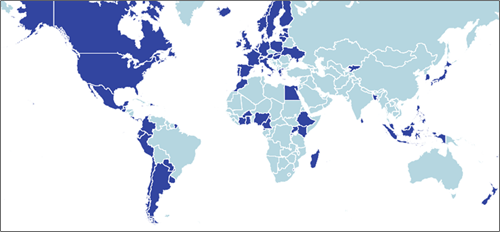
The Helsinki Principles
The Coalition cooperates under the spirit of mutual support and assistance, taking into account the different needs and challenges of member countries. In its work, the Coalition is supported by over 25 international and national organizations acting as ‘institutional partners’ providing strategic and technical advice. The Coalition is becoming an important part of global climate action and it collaborates with key groupings such as the G20, Network for Greening the Financial System, and alike.

Finance ministers hold the keys to unlocking climate action
The Coalition supports active engagement of finance ministries in national efforts to address climate change. This is seen as critical from a horizontal, economy-wide perspective, as finance ministries are responsible for implementing economic, fiscal, and financial policies. It is therefore vital that climate change considerations are mainstreamed in their tools on economic projections and impact assessments, budget planning (expenditures and revenues/taxation), and the analysis of sustainability of public finances. Consequently, finance ministries are key actors of a ‘whole-of-government’ approach to addressing climate change. For this reason, finance ministries need tools and embedded capacity to guide economies towards green transition.
Mainstreaming climate change considerations into concrete economic and financial policies requires major changes in the finance ministries in terms of resources, expertise, and governance. Examples of successful steps in this regard have already been taken, but experiences also show that transformation is not easy. The Coalition provides a forum where its members can learn from the experiences of others and develop tools and practices on this shared journey. The direct involvement of ministers is an important element, as political and technical matters go hand in hand in making progress.
The Coalition work programme 2022 is supporting ministries’ capacity building and transition financing efforts, among other issues. Each Helsinki Principle has its work streams and priorities aiming at concrete deliverables to assist countries in their climate action. The Coalition has published several reports under the Helsinki Principle work streams and regularly organizes workshops and stakeholder dialogues. The 2022 work programme also introduces a new horizontal work stream on financing climate change adaptation. Moreover, understanding the economic policy impacts of nature related risks and biodiversity loss are high on the agenda.
The work programme is supporting the Coalition’s ministerial meetings by building work on their themes. The Coalition ministers meet twice a year in the margins of World Bank and International Monetary Fund spring and annual meetings. The Coalition took part in the Finance Day of COP26 and has been invited to the COP27. The COP26 experience signaled stronger engagement from and an enhanced role for finance ministries in designing climate policies and participating in planning and implementing nationally determined contributions. Finance ministries have a particularly important role to play in achieving the alignment of global financial flows with the mitigation and adaptation goals of the Paris Agreement. The Coalition considers that enhanced capacity and support of finance ministers are critical to keeping warming below 1.5 degrees and ensuring adequate investment in adaptation.
To tackle the climate crisis effectively, appropriate economic policy tools and mobilization of finance from all sources is needed, including the support of international financial institutions. Finance ministries around the world have increasingly begun to acknowledge their key role in mitigating the climate crisis and adapting to its consequences. The Coalition welcomes all countries committed to tackling climate change to join as members. It stands ready to support its members and actively work for coordinated solutions internationally.
Four elements have been identified as important in moving the successful work of the Coalition forward:
Fourth, finance ministries must take part in the design of climate policies at the national level. Traditionally, finance ministries have not been essential participants in the design of climate policies. But, the need to understand the economic and financial consequences of climate change and impact of policies to our economies and public finances is changing this. The Coalition is there to support this transition.
During the 2020-2022 Work Plan period, WGEA produced five work package reports. The reports for work packages 2-4 explore the three thematic areas of plastic waste, climate finance, and sustainable transport. Two reports for work package 5 explore policy coherence and multi-stakeholder cooperation and enhance the understanding of the environmental Sustainable Development Goals (SDGs) through a summary of the three thematic areas noted above. The final work package reports can be found on the wgea.org website.
Work Package 2 – Plastic Waste
Auditing Plastic Waste: Research and Audit Benchmarks for Supreme Audit Insitutions
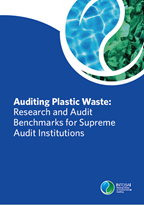
Plastic is everywhere. While it has many good attributes, plastic waste has rapidly become one of the key environmental concerns globally. Plastic waste in oceans and other water bodies is particularly concerning. At the same time, microplastics have become a recognised health concern. By controlling plastic waste, we can protect the environment and avoid health risks. This is a good example of the interlinked nature of the problems with plastic waste - but also their solutions.
This report provides a thorough study on the topic, with practical examples on how to audit plastic waste. The publication also contributes to the follow-up and review of the SDGs, and particularly Goal 12 on sustainable consumption and production. Notably, this report is coming out just a couple of months after the United Nations Environmental Assembly decided to begin negotiations on a legally binding treaty to eliminate plastic waste.
Work Package 3 – Climate Finance
Auditing Climate Finance: Research and Audit Criteria for Supreme Audit Institutions
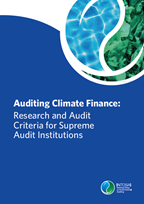
Climate finance is an important topic of consideration as the world becomes increasingly concerned about the effects of climate change. Climate finance is an essential component in enabling climate action, since large-scale investments are needed to both mitigate climate change and adapt to its impacts.
This report focuses on approaches to audit climate finance. It was conducted to help SAIs audit their governments’ contributions toward SDG Target 13.a. This target is to implement the commitment undertaken by developed-country parties to the United Nations Framework Convention on Climate Change to a goal of mobilizing jointly $100 billion annually by 2020 from all sources to address the needs of developing countries in the context of meaningful mitigation actions and transparency on implementation and fully operationalize the Green Climate Fund through the capitalization as soon as possible. As such, this report is meant to identify the indicators SAIs use to assess progress toward achieving this target effectively and efficiently. It includes key questions and example indicators to help SAIs plan effective audits related to SDG 13.a.
Work Package 4 – Sustainable Transport
Auditing Sustainable Transport: Guidance for Supreme Audit Institutions
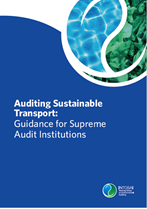
Sustainable transport is a multifaceted concept that includes infrastructure planning, financial arrangements, and providing transport services for citizens. Transport has many environmental impacts and, therefore, a shift toward a more sustainable transport system can have many benefits for the environment and human health.
This report is meant to broaden the perspective of environmental audits and help mainstream environmental work into all sectors of governments. In addition, this publication may reach readers from transport sector audits who might not yet be familiar with environmental or sustainable development concerns.
The publication contributes to the follow-up and review of the United Nations SDGs, and particularly Goal 11 on sustainable cities and communities. In the spirit of sustainable development, it is also connected to several other SDGs, such as goals related to clean energy (SDG 7) and climate action (SDG 13).
Work Package 5 – Policy Coherence and Multi-stakeholder Engagement
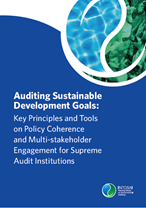
Policy coherence and multi-stakeholder engagement are key to implementing Agenda 2030 and supporting the SDGs. Policy coherence should systematically reduce conflicts and promote synergies between various policy areas on jointly agreed policy objectives. Multi-stakeholder engagement can serve to support policy coherence through an inclusive process. Both concepts are captured within SDG 17: Partnership for the Goals.
This research paper helps develop an understanding of auditing SDGs from an environmental perspective. This paper analyzes information on tools and methods used to assess policy coherence and multi-stakeholder engagement, including environmental concerns in all SDGs. Building on the 2019 WGEA discussion paper on Environmental Audit and the SDGs, this paper addresses the importance of policy coherence and multi-stakeholder engagement from the perspective of environmental auditing, good governance, and effective public spending. In addition to explaining key concepts, it is a practical collection of ideas and tools for SAIs around the world on how to include policy coherence and multi-stakeholder approaches into their work.
Work Package 5 – Understanding the Environmental SDGs
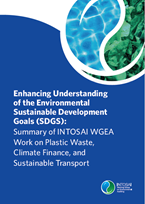
As part of INTOSAI’s strategic plan, the WGEA Work Plan 2020-2022 sought to explore how SAIs can contribute to the follow-up and review of the SDGs.
This paper provides a summary of WGEA’s work on plastic waste, climate finance, and sustainable transport. It aims to enhance understanding of the environmental SDGs among the INTOSAI community by discussing how the SDGs are considered in audit work across the three thematic focus areas, exploring linkages and barriers among them for implementing the SDGs, and providing lessons learned.
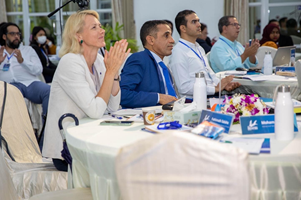
All work packages were presented and adopted at the 21st INTOSAI WGEA Assembly.
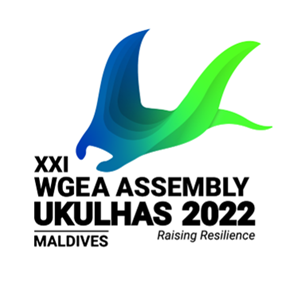
The first half of 2022 has been anything but boring for the WGEA Secretariat. Our teams’ calendars quickly started packing up with various tasks: finishing up the Work Packages; drafting the next Work Plan; innovating a new WGEA Strategy; preparing materials for the UNEP Stockholm +50 meeting and the HLPF side event; and last but not least, organising the 21st INTOSAI WGEA Assembly.
All these various tasks gave the Secretariat the opportunity to produce different products together with our member SAIs. Some of the newer outputs included producing videos and launching a WGEA blog. We also produced two bulletins, a Work Plan and a Strategy. However, the most significant output this year has been the five finalised Work Package reports on plastic waste, climate finance, sustainable transport, and policy coherence and multi-stakeholder cooperation. For these we must thank the Work Package leaders for their hard work and endurance.
The most significant event for the WGEA Secretariat was the 21st INTOSAI WGEA Assembly. This presented a unique challenge: how to arrange an interactive conference after three years of online events? The 21st INTOSAI WGEA Assembly was the first of its kind – a hybrid conference arranged in the Maldives and streamed online to a wider audience. The Assembly was truly a product of global collaboration. The location of the host country of the Assembly, the Maldives, also presented a unique opportunity to highlight the importance of resilience in the context of sea level rise and low-lying island states. The hybrid format of the conference offered a valuable learning experience for future meetings of its kind.
The meeting materials are available at https://www.wgea.org/assembly-2022/, and the seminar summary and videos from the Assembly will be coming to the website soon.
Finally, we are excited to finalise the Work Plan 2020-2022 period and start the next chapter: Work Plan 2023-2025. We are looking forward to launching the work under our two new hubs: climate & biodiversity and green economy!
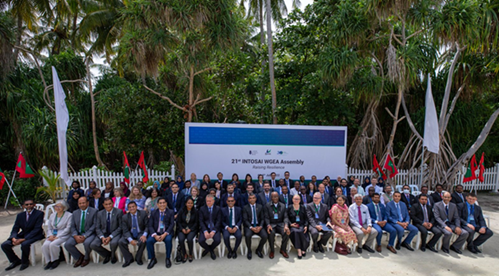
In-person attendees at the 21st INTOSAI WGEA Assembly
Beginning with this Greenlines edition, we are dedicating this space to share information about training options available to SAIs to enhance their knowledge of environmental and performance auditing. Please feel free to send information about additional options so we can share it here, as appropriate.
WGEA Auditing Waste Management MOOC Accredited with E-Course Quality Label
The INTOSAI WGEA Massive Open Online Course (MOOC) on Auditing Waste Management earned an honourable recognition by receiving an e-course quality label from the Estonian Quality Agency for Higher and Vocational Education. The quality label is an acknowledgement of excellent results in the application of digital technology in the learning process. In addition, among those who received the quality label, nine courses—including the MOOC on Auditing Waste Management—were nominated for the title of e-course of the year by the quality label evaluators.

The MOOC on Auditing Waste Management was developed and launched under the auspices of INTOSAI WGEA in 2019. It is a freely accessible e-course, fully online and self-paced. The course materials are available at https://sisu.ut.ee/waste/. While the materials are accessible all the time, the project lead, the National Audit Office of Estonia (NAOE), officially runs the course once a year in cooperation with University of Tartu. Facilitators then also provide support in course discussion forums and aim at encouraging group learning. Participants successfully completing all tasks receive a certificate from the University of Tartu. NAOE will again run the waste MOOC officially at the end of 2022/beginning of 2023. Information will be available via INTOSAI WGEA.

International Centre for Environment Audit and Sustainable Development (iCED) - Sustainability on Campus
SAI India, under the aegis of the Comptroller and Auditor General of India, established the International Centre for Environmental Audit and Sustainable Development (iCED) at Jaipur, India for capacity building of auditors in the area of environment audit and sustainable development. iCED is a designated Global Training Facility of WGEA and the Working Group on Extractive Industries (WGEI).
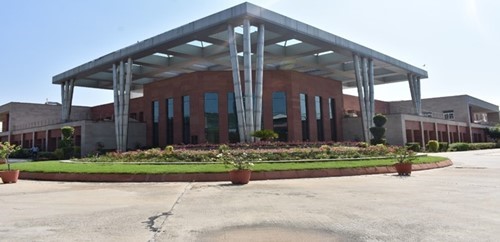
iCED has conducted 32 international programmes for 1,329 participants from 109 SAIs. The number of international participants has greatly increased since 2020-21 due to the online forums utilized, including 762 participants representing 80 SAIs who participated in 2 international webinars, 4 international training programmes, and 2 international workshops.
Sustainability on the iCED campus: SAI India’s Commitment to Green Practices
SAI India has attempted to incorporate environment-friendly features on its sprawling campus. About 85 percent of the campus is a ‘Green Zone’ with variegated flora and fauna. The landscape contains 10,537 plants/trees and 23,699 bushes. There are 141 plant varieties. Located in a normally rainfall-deficient scrubland, the campus seeks to be a part of the living environment by planting predominantly local plant species, whose hardy survival controls excessive wind or soil erosion and acts as a catalyst for groundwater recharge.
Moreover, with its lush green campus, iCED is an ornithological delight. The campus hosts many species of indigenous birds that enrich the biodiversity on the campus, including the Red-wattled Lapwing, Grey Francolin, and Shikra (pictured below from left to right).



Green Features in Design and Construction

The norms prescribed in the Energy Conservation Building Code (2006) of India have been applied for energy efficient design and construction of the building.
Some of these features are:
Green Features in Operations

A Solar Farm (50 KVA) demonstrates the use of clean energy.
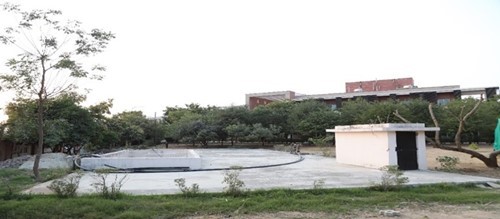
A Sewage Treatment Plant (STP) of 40 Cu. M. per day is
used for wastewater treatment and reuse. Grey water is
treated on the campus and used for the gardens.
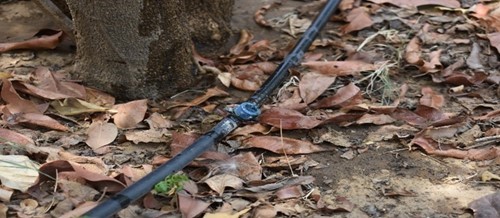
A rainwater harvesting system secures maximum benefit
from each raindrop falling on the campus. Drip irrigation
is used for water conservation.
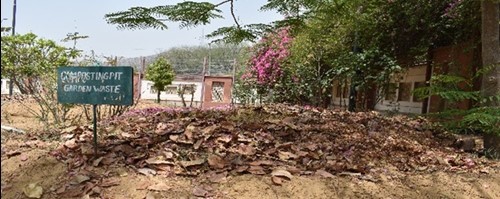
Organic waste (garden, kitchen / food) is composted on
the campus. The use of plastic material is discouraged.
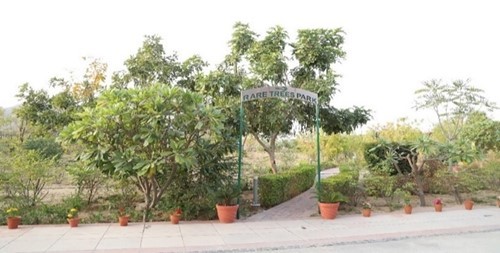
The Rare Trees Park has eight tree species that have
become rare in the region. In addition, 20 herbs/trees
with medicinal properties are also present in this park.
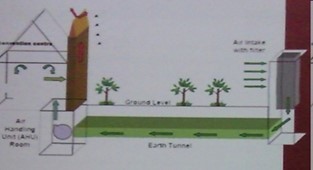
Thermal cooling / heating through an earth air
tunnel to demonstrate technology that uses earth as
a heat sink for cooling in summer and as a heat
source during winters.
Green Files
iCED also publishes Green Files, a quarterly
newsletter featuring glimpses of recent
environmental news, key events, emerging trends,
innovations, initiatives, and efforts of different
organizations to protect the environment. To date,
a total of 42 volumes of Green Files are available
on iCED’s website at www.iced.cag.gov.in.
With the joint efforts of member SAIs and support from the INTOSAI WGEA Secretariat, ASOSAI WGEA earnestly performed its duties and made continuous efforts to complete tasks on schedule in accordance with its 2020-2022 Work Plan.
8th seminar on environmental auditing, 8th meeting of ASOSAI WGEA held online
ASOSAI WGEA held its 8th seminar virtually at the end of October 2021. The seminar included a Green Vision Award ceremony, in which the first Green Vision Award of ASOSAI WGEA was presented to SAI Thailand. In addition, ASOSAI WGEA’s new logo was unveiled during this meeting. To better understand SDGs, Dr. Liu Jian, Director of the Science Division of UNEP, and Dr. Li Haisheng, President of the Chinese Research Academy of Environmental Sciences, were invited to deliver keynote speeches on Audits of Climate Change and The Role of Audits in Promoting Government Accountability for the Environment, respectively, in the seminar. More than 100 representatives from 23 member SAIs attended the meeting.

Cooperative environmental audits and cooperative research implemented
Starting from the end of 2020, ASOSAI WGEA has successively carried out two cooperative audits on Water Resource Management in the Mekong River Basin and Sustainable Transport, respectively, and one cooperative research project on Green Finance.
The cooperative audit on Water Resource Management in the Mekong River Basin was completed in February 2022. For the cooperative audit on Sustainable Transport, three SAIs have submitted their reports and the project is scheduled to be completed by the end of 2022 in the context of ongoing COVID-19 pandemic. The cooperative research project on Green Finance is pressing ahead on scheduled activities.
Increased sharing of environmental auditing cases and experience within ASOSAI
As the chair of ASOSAI WGEA, the National Audit Office of China (CNAO) attended virtual seminars on environmental auditing within the INTOSAI community, such as the Meeting of the Heads of BRICS SAIs and COP26 Seminar of the INTOSAI WGEA. This helped to give full play to its role as a bridge of communication and share the experience and practices of ASOSAI WGEA.
To promote environmental auditing within ASOSAI and research and training programs of INTOSAI WGEA, the Secretariat of ASOSAI WGEA made great efforts in intra-regional coordination and trans-regional communication via teleconferencing, emails, etc. The Secretariat also actively responded to environmental surveys initiated by INOTSAI WGEA and its member SAIs. Meanwhile, the Secretariat shared timely information on the progress and achievements in environmental auditing of its member SAIs via a special column Greenshare on the official website of ASOSAI WGEA.
Future priorities
ASOSAI WGEA will continue to perform its duties in an earnest manner and take the initiative in carrying out relevant tasks. This year, it will hold the 3rd online training program on environmental auditing and launch the 2nd Green Vision Award evaluation. It will also collect useful conclusions from the regional cooperative audits and cooperative research to facilitate knowledge sharing and experience exchanges among its member SAIs. ASOSAI WGEA will also deliver more efforts in research relevant to INTOSAI WGEA and strengthen communication and exchanges with other regional working groups.
 Australia : Management of Threatened Species and Ecological Communities
Australia : Management of Threatened Species and Ecological CommunitiesAustralia’s Auditor-General recently presented the following environment-related performance audit to the Australian Parliament: Report No. 19 of 2021–22: Management of Threatened Species and Ecological Communities under the Environment Protection and Biodiversity Conservation Act 1999 (March 2022).
This audit assessed the effectiveness and efficiency of the management of threatened species and ecological communities under the Environment Protection and Biodiversity Conservation Act 1999 (EPBC Act). The audited entity was the Department of Agriculture, Water and the Environment (the department).
The audit concluded that the department’s administration of threatened species and ecological communities under the EPBC Act is partly effective, and the department is unable to demonstrate it is efficient. The audit found that listing assessments, conservation advice, recovery plans, and threat abatement plans are largely completed in accordance with the EPBC Act, but procedural guidance needs updating and is not consistently followed. The department does not effectively review or support the implementation of conservation advice, recovery plans, and threat abatement plans. Measurement, monitoring, and reporting does not indicate desired outcomes are being achieved.
The full report is available at: https://www.anao.gov.au/work/performance-audit/management-threatened-species-and-ecological-communities-under-the-epbc-act.
 Czech Republic : Funds for Waste Management
Czech Republic : Funds for Waste ManagementIn the last issue of Greenlines, SAI Czech Republic reported on ongoing and planned environmental audits. One of these audits, State and European Union (EU) funds earmarked for the implementation of waste management measures, has now been completed. The most important findings are described here.
Not all waste management programme objectives will be met, even though the Ministry of the Environment has set up support for the Operational Programme Environment 2014–2020 (OPE) in accordance with the hierarchy of waste management methods set out in the Waste Act and the binding part of the Waste Management Plan of the Czech Republic for the period 2015–2024. This is because the funds provided for the OPE did not contribute to increasing the capacity for waste recycling or to building new capacity for energy utilization of other wastes or their modernization, according to the set objectives.
Although landfilling is the least appropriate way to manage waste, in 2020, 48% of municipal waste was landfilled. Landfilling continued to be the most common method of municipal waste management in the Czech Republic.
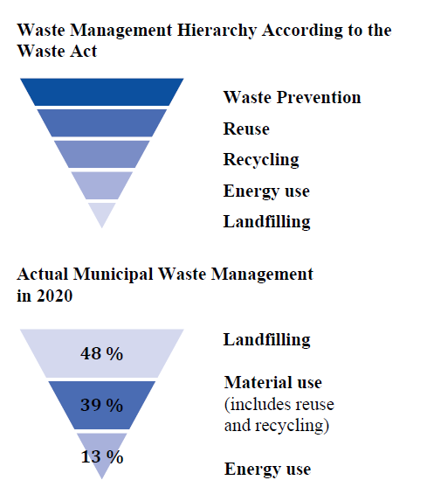
In the years 2015 to 2020, the Ministry of the Environment did not use financial instruments to support the landfill ban stipulated by law in 2024 so that it could be achieved. Between 2016 and 2020, the capacity of landfills for the disposal of other waste, including municipal waste, increased by 17%.
For further information or more details, please contact Michal Rampír or Sylva Müllerová at michal.rampir@nku.cz or sylva.mullerova@nku.cz.
 Egypt : Environmental Performance of Companies in the Metals Industry
Egypt : Environmental Performance of Companies in the Metals Industry SAI Egypt audited companies in the metals industry regarding compliance with environmental requirements. These companies must follow the environmental law and its executive regulations, and all companies have an environmental record.
SAI Egypt recommended taking measures to reduce pollution from manufacturing operations. Air pollution is produced by company activities, such as gas emissions, pollution from chimneys of melting furnaces and various production processes, gaseous pollution resulting from the electrolysis of alumina in aluminum reduction cells, and gas pollution from other industrial processes. Pollution related to the aquatic environment (river, marine, underground) and land include solid and liquid hazardous waste, liquid chemical waste, bottles, solid waste, oil, grease and chemical spillage, dirt and carbon pollution, and fine quartz and coal waste.
Concerning these companies’ efforts to protect the environment from pollution, companies have taken significant steps to reduce the emission loads from the factories. They have implemented a group of environmental enhancements, taking measures to comply with local laws and regulations, international agreements and treaties, and adopt integrated conditions for the Egyptian Environmental Affairs Agency.
In the same context, companies installed environmentally friendly induction furnaces and made contracts with the Environmental Studies Center to work on an “environmental renovation plan” that complies with environmental laws and preserves the environment. Companies also carry out periodic measurement of gaseous emissions, recycle solid waste, dispose of hazardous residuals through special agencies in coordination of the Environmental Affairs Agency, make annual environmental measurements, and make contracts with specialized companies to dispose of environmental waste.
Within the scope of social responsibility, companies have enrolled their employees in a health program for regular checkups and medical treatment. Further, they supply workers and employees with safety tools and thermal insulation of vapor pipes to prevent workers' exposure to high heat.
The most important findings are that the companies’ environmental records show that their pollution rates are within the standard accepted rates, the companies did not bear environmental fines, they took measures to reduce the negative effects of pollution sources, and they implemented several investment projects related to environmental activity.
The most important recommendation SAI Egypt made is for the companies to take the necessary measures to reduce adverse impacts of pollution sources in order to keep the work environment safe for workers and the surrounding environment.
 Estonia : Estonia Environmentally Harmful Subsidies
Estonia : Estonia Environmentally Harmful SubsidiesThe National Audit Office of Estonia (NAOE) published an overview report on mapping, evaluating, and phasing out different types of state subsidies that may counteract environmental objectives—known internationally as environmentally harmful subsidies.
The overview showed that in Estonia, just like elsewhere in the world, there are various state supported schemes, tax exemptions and reductions, or incentives in place that may have a negative environmental impact. The highest number of such subsidies can be found in the energy, transport, and agriculture sectors. For example, these subsidies may support renewable energy for burning wood in an energy power plant, provide various incentives for enterprises with high-energy consumption, lower excise duty on fuel, and reduce an environmental charge for depositing waste. These subsidies might be put in place to handle and recover from COVID-19 and political crises, but in the longer term, they are an inefficient use of state money and hinder the achievement of environmental and climate objectives.
The report found that environmentally harmful subsidies have not been mapped in Estonia, their impact has not been assessed, and a goal has not been set to gradually phase these subsidies out.
NAOE recommended that the government designate a responsible governmental authority, identify all environmentally harmful subsidies, and evaluate their socio-economic, fiscal, and environmental impacts. After that, it would be possible to phase out those subsidies that have a significant adverse environmental impact and that are ineffective. Also, the aim should be to avoid establishing new subsidies that could potentially be environmentally harmful.
A summary and the full text of the report in English is available at https://www.riigikontroll.ee/tabid/206/Audit/2544/language/en-US/Default.aspx.
For more information, please contact Ms Airi Andresson at airi.andresson@riigikontroll.ee.
 India : India Industrial Pollution in West Bengal
India : India Industrial Pollution in West BengalRapid industrial expansion in the eastern state of India, West Bengal, has given rise to significant pressures on the environment. The State contains diverse industries, like mining, iron and steel, petroleum, chemicals, tanneries, and paper mills, which cause significant amounts of pollution. The West Bengal Pollution Control Board (WBPCB) under the Department of Environment, Government of West Bengal (GoWB), has been entrusted with the responsibility of regulating and implementing environmental laws and rules within the State including those that relate to industrial pollution.
The performance audit on ‘Control of Industrial Pollution in West Bengal’ examined the initiatives taken by WBPCB for the prevention, control, and monitoring of industrial pollution in the State. We examined the Environment Clearance (EC) process of 64 grossly polluting industries (out of 131 grossly polluting industries in the State) that were granted EC by the GoWB. (The EC process involves an environmental impact assessment of potential projects.) The audit also checked the environmental monitoring and inspection mechanisms of 51 grossly polluting industries in the State.
We observed that WBPCB had not prepared a Zoning Atlas for the State, which is the first step to prevent and control pollution. Industrial siting policy was violated with heavily polluting industries being set up in municipal areas of Kolkata and in three critically polluted cities, where setting up of new industries was restricted.
We observed deviations from the official process of granting EC to industries in 50% of the industries to which EC was granted during the period under audit. As of July 2017, out of 5,452 red category industries in the State, 65% did not have valid permissions to operate, indicating these industries were run without any environmental pollution control mechanisms in place. (Red category industries are those with the highest pollution index based on air pollutants, water pollutants, hazardous wastes generated, and consumption of resources.)
We further observed that out of 1,281 hazardous waste generating units, authorisation of only 252 units was valid. Only 474 units were registered as hazardous waste treatment facilities. In addition, 41% of the registered units that were generating hazardous waste resorted to illegal disposal, thus causing severe pollution.
We observed that CO2 emissions and PM2.5 levels exceeded the permissible limits. As such, air pollution levels were at levels that were harmful to the environment and health of people. WBPCB had monitored only 33% of the 131 grossly polluting industries. From the available monitoring reports from January to March 2017, it was observed that 80 of the 131 grossly polluting industries had not complied with discharge standards, thus causing water pollution.
Inspections of the grossly polluting industries were inadequate due to lack of infrastructure and manpower, and only one laboratory in the state accredited for testing pollution levels. This hampered surveillance and monitoring of the grossly polluting industries.
 Tanzania : Tanzania Conservation and Protection of Wetland Ecosystems
Tanzania : Tanzania Conservation and Protection of Wetland Ecosystems In April 2022, the Controller and Auditor General (CAG) of the United Republic of Tanzania, Mr. Charles Edward Kichere, submitted to the Parliament the Performance Audit Report on the Management of Conservation and Protection of Wetland Ecosystems in Tanzania.
The main reason SAI Tanzania conducted this audit was because the Wildlife Management Division of the Ministry of Natural Resources and Tourism (MNRT) recorded a loss of wetlands in 2015. This loss was mainly due to uncontrolled encroachment and increased human activities in the wetland ecosystems. This increased the risk of reduction of water available for activities such as agriculture, transportation, fishing, and irrigation.
The overall objective of the audit was to determine whether the Vice President’s Office - Division of Environment (VPO - DoE), President’s Office - Regional Administration and Local Government (PO-RALG), and MNRT effectively implemented measures for conserving and protecting wetland ecosystems. The audit covered three financial years from 2018/19 to 2020/21.
The audit found that VPO - DoE did not facilitate the implementation of the National Wetland Management Strategy as required by the Environmental Management Act No. 20 of 2004 (Act). Generally, the VPO - DoE did not make efforts in planning and training to facilitate the adaptation of the strategy. For example, the guideline for wetland management was not distributed to key stakeholders such as the PO-RALG. Furthermore, the VPO - DoE did not adequately monitor the status of the management of wetlands in the country even though it is required to do so in accordance with the Act.
MNRT did not provide adequate support to the VPO - DoE on the conservation and protection of wetlands, contrary to the requirements of the Guidelines for Sustainable Management of Wetlands of 2014. Moreover, PO-RALG did not integrate the National Wetland Management Strategy into their plans through the Local Government Authorities as required by the National Strategy for Sustainable Wetlands Management Program, 2011 - 2020.
The audit concluded that the Government, through the VPO - DoE, PO-RALG and MNRT, did not devise mechanisms to ensure effective conservation and protection of wetlands in Tanzania. The CAG recommended that the Government address the issues raised above in order to avoid or minimize the rate of encroachment and degradation of wetlands in the country.
A copy of a Performance Audit Report on the Management of Conservation and Protection of Wetland Ecosystems in Tanzania is available on SAI Tanzania’s website at http://www.nao.go.tz.
For further information, please contact Mr. George C. Haule at George.Haule@nao.go.tz and Mr. Frank Mwalupale at Frank.Mwalupale@nao.go.tz.

The INTOSAI Working Group on Environmental Auditing (WGEA) aims to increase the expertise in environmental auditing and to enhance environmental governance with high-quality contribution and visibility by both members of the Working Group and non–member SAIs. Currently the INTOSAI WGEA consists of 86 member countries.

Vivi Niemenmaa - Secretary General
Email: vivi.niemenmaa@vtv.fi
Nella Virkola - International Affairs Planner
Email: nella.virkola@vtv.fi
Raisa Ojala - Deputy Secretary General
Email: raisa.ojala@vtv.fi
India Roland - International Affairs Planner (on leave)
Email: india.roland@vtv.fi
Kati Hirvonen - Project Specialist (on leave)
Email: kati.hirvonen@vtv.fi
Emilia Linnekoski - Intern
Email: emilia.linnekoski@vtv.fi
Sari Suonpää - Intern
Email: sari.suonpaa@vtv.fi
Mohamed Ibrahim Jaleel - Environmental Audit Manager
Email: mohamed.jaleel@audit.gov.mv
We collect and process your data on this site to better understand how it is used. We always ask you for consent to do that. You can change your privacy settings here.